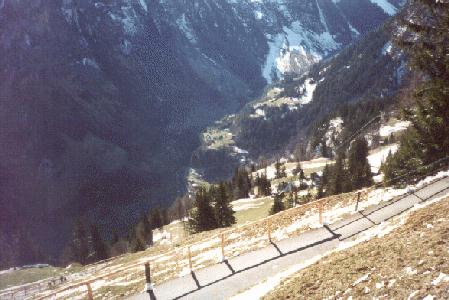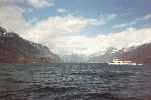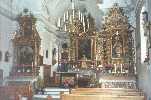INTERLAKEN TO CHUR
Monday 31/3 dawned clear as crystal. Elaine was determined to
head for the Jungfraujoch, while Denis and I opted for Mürren
and Gimmelwald. Louise (and a million local skiers) came with us,
while the others split between the Jungfrau and Grindelwald.
There was still a lot of snow on the ground in Mürren and as
we headed down the hill towards Gimmelwald, but we soon worked up
a sweat, the day was so warm. We walked all the way down the
mountain to Stechelberg, then took the cable-car back up to
Mürren where we caught the train back to Lauterbrunnen
and Interlaken.

We walked all the way down into the valley, from Mürren to Stechelberg
The scenery on the mountain was a feast for the
eyes - grassy patches dotted with blue and white crocuses, white
bellis perennis, blue and purple violas; dark forest where Little
Red Riding Hood would have been at home; and dark timber houses
with adjacent byres, where the cows' tails were tied with string
to overhead ropes to stop them getting soiled by the inevitable
dung (winter lasts a long time in the mountains).
When we got back to the youth hostel
I rang Chris Reuss, my EB connection in Chur, to say we wouldn't
be catching the train to Disentis after all, as advised by the
clerk in Zurich. Chris took it very calmly, then rang back about
half an hour later to assure me that we could indeed come that
way, and he would meet us in Disentis as originally planned.
Back to plan A for 2/4!
The itinerary for the next day (1/4)
read:"Interlaken to Luzern - by BIKE. Via Brienz. Interlaken
to Brienz @16k, Brienz to Luzern @ 60k. Will have to take train
for part of the journey as the Brünig Pass is very steep."
(This info was from Patrick, who had met us in Zurich) What
the heck, we thought, this sounds like hard work, we've got our
Swiss passes, let's use them. So we spent the morning sightseeing
in Interlaken, then caught the lake ferry to Brienz, had a quick
cycle around the town, which was closed for lunch, then caught
a Stop-train to Luzern. I'm glad we didn't ride - the train had
a hard enough time getting up the pass! Anyway, we were getting
heaps of exercise lifting the bikes on and off the trains ;-)
 Lake Brienz near Interlaken |
 Ancient city walls, Luzern |
By catching the train we had time
for a bit of sightseeing in Luzern before nightfall - the painted
bridges, the lion monument, the 14th century city wall. We walked
the perimeter of the wall, and found, to our delight, a small
herd of cows, bells and all, grazing on the hill, just outside
the wall, right in the middle of the residential area. We had
to pinch ourselves to make sure we weren't dreaming. That night
we found our way in to town and had baby goat stew for tea - that
sure beat the spag bol on offer at the youth hostel.
Up early next morning as we had to
catch our first train at 8.20 am. This morning was going to be
a feat of endurance involving three changes of train, followed
by 70 k of mountain roads through farmland, villages, and forest.
The guard on train #1 was a bit skeptical of our chances of completing
the jouney (that really helped relieve the stress I was feeling,
as it was all down to me, being the one who had made the
arrangements with Chris in the first place!), but we pressed on
regardless. We had 8 minutes grace at
Arth/Goldau, 11 minutes at Göschenen, and about
5 minutes at Andermatt. The little train between Göschenen and
Andermatt proved the tightest squeeze - 8 bikes plus 16 panniers
was almost more than the baggage car could hold. Luckily there
weren't many other people on the train.

We saw Wassen 3 times as the train corkscrewed up the mountain
Chris met us at Disentis as arranged.
There was no platform where we pulled up, just some asphalt between
the tracks, so of course we got out on the wrong side and had
to wait for the down train to depart before we could cross the
track and actually say hello.
In his e-mail message Chris had painted a wonderful picture of
the path from Disentis (1140m above sea level) to Chur (590m a.s.l.).
He mentioned the downhills, and the long straight stretches, but
somehow I missed any mention of the HUGE UPhill that connected
the straight stretch to the downhill :-). That all changed when
Chris handed out the ride profile he had prepared. On the profile
we could see what was awaiting us: 55k downhill or straight stretches
and 15k uphill, mainly in the second half, from Ilanz (700m a.s.l.)
to the local maximum (940m). We would really get to know these
mountains :-). The path is signposted all the way from Disentis
to Chur so intrepid souls could tackle it themselves, as long
as they were prepared to defy the Swiss National Railways!
Our first stop en route was 1.6k downhill from Disentis, where
we dipped our fingers in the pristine Rhine just 10 miles (16
k) from its source (1025m a.s.l). From there we climbed up to
the other side of the valley: The 1.7 km up to Cavardiras (1130m)
form the steepest stretch of the whole tour - designed for "warming
up" :-) , especially with 15kg of luggage hanging off the bike...
We stopped in the tiny village of Cavardiras, where Chris took us into the Church of St Anthony of Padua (Sogn Antoni da Padua),
 Inside Chris' little church, Cavardiras |
In Campadials Elaine, Louise and Denis missed the signpost and rode on up the main road. Mary stopped a car and asked the driver "Do you speak English ?" - He replied "No." :-} But she finally convinced one of the drivers to tell the 3 cyclists up ahead to turn around and come back.
After a fast downhill we lunched at a stone fountain in the middle
of the quiet and cosy village of Surrein and talked about some
details of rural living there. While we ate our rolls filled with
cheese and meat , Chris just sipped from his water bottle. Given
the vigour and ease with which he attacked the hills later in
the day, we still don't believe his claim that it only contained
water! ;-)

Lunch by the fountain in Surrein, Louise, Elaine, Roy, Lenore, Chris, Russell, Kim, Mary
Then we rode on through a muddy and bushy area which almost resembled
the Australian landscape. After these quite bumpy trails we were
happy to take the straight fast road (almost without cars) from
Trun to Tavanasa (7 k), followed by 12 k on a lonely path through
quiet forests as far as Ilanz. We were impressed with the old
fairy-tale forests with little brooks running through them. Ilanz
is the first city on the Rhine, midway between Disentis and Chur.
Some of us bought more food here, mainly bananas, as our bodies
were running out of fuel. We then faced the challenge of the next
section, a long uphill, climbing from 700 to 940 m a.s.l.
The roads through the old Rhaetian villages hug you tight, so
that it becomes a very personal experience. You are not just looking
on, you become part of the picture. Some workmen, and later some
children at a campground we passed, called out "Hopp, hopp,
hopp!" as we rode by. I knew I'd heard it before, but couldn't
remember the context, so I asked Chris. With a wry smile he answered
that that's the call used to encourage competitors in the Tour
de Suisse, etc. They were basically giving us a bit of cheek because
of our helmets (mandatory in Australia) and cycle clothing. We
appreciated the joke ourselves, and were pleased with the interaction
with the locals.
In Valendas we saw the largest wooden fountain of Switzerland. An old man there was quite surprised to meet 8 cyclists from Australia and chatted a bit with us (Chris was translating). Elaine gave him a small Australian flag, which he touchingly pinned through the button-hole of his jacket.
Mary and I were the only two that didn't ride all the way up the
mountain- we stopped about 100m short of the top and walked (Mary
had the 'flu, I was just pooped!) At this point Denis insisted
I eat a banana to boost my energy. I was pretty irrational by
then, and only Mary's presence stopped me from shoving it back
in his face :-(
The payoff for this hard slog was the wonderful downhill run that
followed. We didn't go too fast at the start as there are a number
of hairpin bends that check your speed, but the sight of the 70m
deep gorge under the Rabiusa bridge was spectacular. We then climbed
back up to 780m a.s.l. and were confronted with the fabulous sight
over the Rhine Gorge (also known as the "Grand Canyon of
Switzerland"). From the road along the mountain side you
can look down the 170m drop to see to the Rhine meandering its
way through the chalky rocks far below. This is the main tourist
attraction of the whole stretch.
From there we enjoyed a fast straight downhill through the forest
until Bonaduz, and another on to Reichenau, where we passed the
point where the Vorderrhein and Hinterrhein meet.. Coming in to
Chur the Rhine virtually disappears - it gets siphoned off sideways
to perform hydro-electric feats, then reappears after it has done
its duty. The cyclepath leads right over the dam at Domat/Ems
and then along the dry "small canyon" of the Rhine.
Although it was a great sunny and cloudless day, the fast downhills
through the forests were quite chilly, so it was just as well
Chris had advised us to wear "onion-style" clothing,
i.e. layers that you can peel off and put on as you need them.
Chris had arranged accommodation for us at the Hotel Rosenhugel
(Rosehill). We had intended to stay at the youth hostel that's
mentioned in the Hostelling International guide; but Chris
was kind enough to inform me, before we left home, that that youth
hostel would not re-open until 1998. Now, the Hotel Rosenhugel
is well named - I'm not too sure about the "rosen",
but "hugel" it definitely was, especially when approached
from the 'scenic' side. The effort of that afternoon had caused
me to "hit the wall", so much so that I removed my panniers
and slowly trudged up the hill, leaving my bike down below for
someone, anyone, to cart away. Luckily that someone was Denis
who carted it away into storage for the night.
The rooms were clean and spacious, and had broad views over Chur.
Chris had booked 3 basic rooms and one with an ensuite. Now, the
ensuite was a bit of a challenge, as there were 8 of us, all unrelated
except for Denis and me, four men, four women, and the ensuite
was a perfectly clear perspex cubicle attached to the wall of
Louise and Elaine's bedroom. Needless to say, they went to bed
quite late that night! Would you trust them not to peek?
After a leisurely breakfast next day Chris took us for a guided
(walking) tour around Chur, the oldest city in Europe, having
been continuously inhabited since 3000 BC. In years gone by the
Bishop of Chur had his own walled town, a mini Vatican, located
above the town proper, and, of course, he had his own vineyard.
The town has been incorporated into Chur now, but the Church still
owns the vineyard.
We Aussies were all a bit bemused by the vans we saw with "Gastro"
proudly painted on their flanks. To us "gastro" is short
for gastroenteritis, a rather nasty stomach bug. We were much
relieved when Chris explained that here it was short for 'gastronomy',
or the art of fine food!
After munching lunch in the park opposite our hotel, Chris led
us to the "bike highway" he had promised in his first
EB response. He rode with us for about an hour and a half , out
of Chur and on along the Rhine, to Maienfeld where we took a detour
through its old town full of corners and the popular vineyards,
and back to the Rhine where it was time for him to turn back home.
We were sad to part from our own private tour guide ;-) Thanks
Chris, you showed us sights that most tourists never see, and
that mountain ride will never be forgotten. We will try to do
the same for you when you get the opportunity to come to Australia.